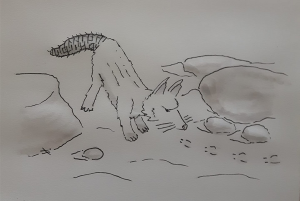Difference between revisions of "Daegt"
From World of Entorais Wiki
Jump to navigationJump to searchm (layout) |
m (Text replacement - "Anexea" to "Annexea") |
||
| (4 intermediate revisions by the same user not shown) | |||
| Line 1: | Line 1: | ||
[[File:snowy_daegt.png|thumb|right|100x|Snowy Daegt - "Sebastian Romu" © 2019]] | |||
==About== | ==About== | ||
:Daegt are long bodied nocturnal predators with long smooth nearly hairless tails. | :Daegt are long bodied nocturnal predators with long smooth nearly hairless tails. | ||
;Common Names: Daegt, Fox-Rat | ;Common Names: Daegt (Waejir), Fox-Rat, Tyas (Kythus) | ||
==Description== | ==Description== | ||
| Line 20: | Line 21: | ||
;Reproduction:Mated pairs will produce small litters of 3-4 cubs every spring, which are capable of hunting for them selves by summers end. Daegt reach sexual maturity at about 16 months. | ;Reproduction:Mated pairs will produce small litters of 3-4 cubs every spring, which are capable of hunting for them selves by summers end. Daegt reach sexual maturity at about 16 months. | ||
==Sub-Species== | ==Notable Sub-Species== | ||
===Common Daegt=== | ===Common Daegt=== | ||
:The common daegt is found in most lightly wooded or grassy areas. Common daegt have a dark sable coloured fur popular as a trim for cold weather clothing. | :The common daegt is found in most lightly wooded or grassy areas. Common daegt have a dark sable coloured fur popular as a trim for cold weather clothing. | ||
| Line 28: | Line 29: | ||
===Marsh Daegt=== | ===Marsh Daegt=== | ||
:The marsh daegt is found in reedy marshes, and fens throughout [[ | :The marsh daegt is found in reedy marshes, and fens throughout [[Annexea]]. They tend to dingy brown and grey colours which blend into their environment. Their tails have a flat sided form, and their paws have partial webbing, to assist with swimming. | ||
===Snowy Daegt=== | ===Snowy Daegt=== | ||
:The snowy daegt is common in northern climes, and alpine regions where | :The snowy daegt is common in northern climes, and alpine regions where its white fur helps keep it camouflaged during the winter season. During warmer months the snowy daegt develops darker grey and brown patches of fur. The white pelt however are prized for their warmth and colour. The tails of the snowy daegt are shorter and thicker, with a heavy layer of fat to preserve heat in the cold climate. | ||
==Domestication== | ==Domestication== | ||
Latest revision as of 15:00, 2 July 2024
About
- Daegt are long bodied nocturnal predators with long smooth nearly hairless tails.
- Common Names
- Daegt (Waejir), Fox-Rat, Tyas (Kythus)
Description
- Classification
- Mammal
- Size
- The average adult weighs about 30 kg (66 pounds), stands about 75 cm (30 inches) at the shoulder, and measures nearly 2 meters (80 inches) in length nose to tail.
- Appearance
- Long bodied with short legs. large triangular ears, long pointed snout, with pronounced whiskers, and a long rough skinned, nearly hairless tail.
- Sexual dimorphism
- Very little variation between the sexes other than sex organs.
- Variance
- Sub-species of Daegt are well adapted to differences in terrain and temperate.
Ecology
- Habitat
- Daegt are found in a wide variety of terrains and climates. The various sub-species are adapted to the particular conditions of the regions they frequent.
- Diet
- Scavengers and opportunistic predators. Known for their keen eyesight and excellent sense of smell, these creatures will track small animals to their dens, or nests and attack while the prey is still asleep. They are also capable of digging in mixed or loose soil to unearth burrowed prey with their long broad clawed fore paws.
Behaviour
- Social grouping
- Daegt are usually found in small family packs of two adults and their 3-4 cubs, although larger groupings have been reported with multiple female adults.
- Temperament
- Wary. Daegt tend to be alert to threats, but don't always flee, instead lingering around to possibly obtain scraps from the kills of larger predators.
- Intelligence
- Clever animal
- Reproduction
- Mated pairs will produce small litters of 3-4 cubs every spring, which are capable of hunting for them selves by summers end. Daegt reach sexual maturity at about 16 months.
Notable Sub-Species
Common Daegt
- The common daegt is found in most lightly wooded or grassy areas. Common daegt have a dark sable coloured fur popular as a trim for cold weather clothing.
Desert Daegt
- The desert daegt is found both in the Krolaryn Wastes and the rockier areas of the Waejiran Desert. This species has shorter fur ranging from tawny to reddish, rusty colours.
Marsh Daegt
- The marsh daegt is found in reedy marshes, and fens throughout Annexea. They tend to dingy brown and grey colours which blend into their environment. Their tails have a flat sided form, and their paws have partial webbing, to assist with swimming.
Snowy Daegt
- The snowy daegt is common in northern climes, and alpine regions where its white fur helps keep it camouflaged during the winter season. During warmer months the snowy daegt develops darker grey and brown patches of fur. The white pelt however are prized for their warmth and colour. The tails of the snowy daegt are shorter and thicker, with a heavy layer of fat to preserve heat in the cold climate.
Domestication
- General
- Daegt are sometimes domesticated for vermin control, or for tracking and hunting of small game.
- Resources
- Fur, Fat (Snowy Daegt)
